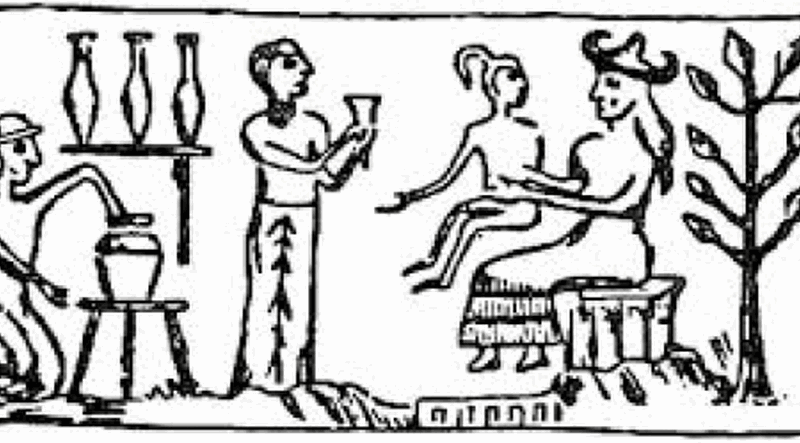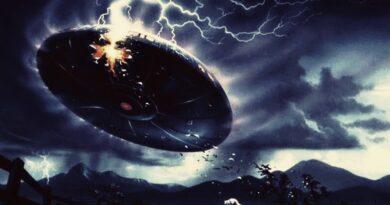The creation of man
The failure of Enki and Ninmah
Failure to create a human being: Why do the recovered Sumerian tablets speak of attempts to create mankind? Because like any respectable experimentation in order to improve something, we proceed in small steps, the same did the Anunna scientists when they decided to make the first human being.
In the poem of ATRAHASIS, (the great sage), written in the Akkadian language dating back to 1700 BC, the events that led to the creation of man are described. The minor gods, called Igigi, could not bear the enormous workload that had been imposed on them by their ancestors, the Anunnaki gods, so they started a revolt. The Anunnaki at that point decided to create a substitute to work the earth in place of the Igigi, a creature “who could bear the yoke of the gods” and who guaranteed their livelihood with his work on earth. Enki and the goddess Mammu created man (Lulu), mixing the flesh and blood of a lesser god sacrificed for the occasion into clay.
The creation of the first man by the Annunaki gods
In addition to the aforementioned creation myth, there is another text from the second millennia BC, entitled “Enki and Ninmah”, from which we learn that the creation of man was not at all simple. Creation also went by trial and error in the Mayan creation myth, the feathered serpent god and other primeval deities failed to create man on the first try. Even in that version, very far both in time and space, some tests were needed before reaching the desired result (the first two attempts failed, “the clay man” and “the wooden man”, while the third went to good end, “the corn man”). As in the Mayan tradition Quichè also in the Mesopotamian one the myth of “Enki and Ninmah” reports the list of unsuccessful attempts, while the successful one is found both in the poem of ATRAHASIS (the great sage) and in the ENUMA ELISH (the poem of creation). The myth of “Enki and Ninmah” in a certain sense could be considered an appendix of the ATRAHASIS or of the ENUMA ELISH an in-depth study of the events that involved the creation of man.
Contents of the clay tablet “The myth of Enki and Ninmah”, Louvre Museum – Paris
The text opens with the situation already described in ATRAHASIS (the great sage). The gods are divided into two categories: the Anunnaki and the Igigi. The latter, as lesser gods, were responsible for hard work on earth, indispensable for the sustenance of their Anunnaki ancestors. The Igigi, tired of this life, crossed their arms and began to protest for their uncomfortable condition. In the myth of “Enki and Ninmah” the details of the protest are left out, but thanks to the content of the ATRAHASIS we know that it was not a peaceful protest at all, but rather a tumultuous revolt that reached the gates of the home of Enlil, the god who reigns over land. According to the myth of “Enki and Ninmah” the lament of the Igigi also reached Apsu, the home of Enki, who was awakened by all that noise. Namma (or Nammu, probably the primordial mother of the gods whom the Babylonians in the Enuma Elish call Tiamat) explained to Enki the reason for so much noise and suggested that he release the Igigi from the burdensome task, creating a substitute who could carry the yoke of work in their place. Enki in his great wisdom decided that such a thing was feasible, so he summoned his sister Ninmah (Ninhursag) and gave her the necessary instructions to create man, plus he had the goddesses of birth summoned in order to assist his sister in that. ‘Opera.
Extract from the tablet of the myth of “Enki and Ninmah”
In those days, the days when heaven and earth were created,
In those nights, the nights when heaven and earth were created,
In those years, the years when destinies were set,
when the gods Anunna begat,
when the goddesses (mothers and daughters) got married,
when the goddesses (mothers and daughters) inhabited heaven and earth,
when the goddesses (mothers and daughters) became pregnant,
and the gods had to bring food to the dining rooms,
the greater gods supervised the work, and the lesser gods carried
the yoke of work.
They worked the canals of the land of Arali, in the earth and in the clay,
but they stopped work to complain about this life.
On that day the creator, the great god of great wisdom,
Enki, in his Engur, the place of groundwater that no god knows,
he slept in his rooms and was awakened
from the gods who complained
and got up from his bed.
The goddess Namma, the first mother who gave birth to the gods,
brought the tears of the lesser gods to her sleeping son,
to him who lay in his sleep,
(….)
“God the Creator, your creatures complain,
son, get up from your bed, turn your gaze, yours
wisdom,
create a substitute for the gods, so that they are free from the yoke
of work “
(translation:http://gizidda.altervista.org/container/sumerian_myths_translated_finale.pdf)
One of the creatures created by Ninmah with clay
Ninmah took the clay as directed by Enki and modeled the creation, but all his creatures had serious defects that did not allow him to perform the task for which they were intended, which is to work on the earth in place of the Igigi in order to bring the food in the dining rooms of the gods. Ninmah, assisted by the goddesses of birth, made six attempts but I never find the right recipe to create an accomplished man. The first man could not use his hands, the second man had vision problems, the third could not walk, the fourth did not hold urine, the fifth was a woman but could not give birth, and the sixth had no genital organs . Ninmah’s attempts proved to be a total failure and the latter indulged in disconsolate sorrow for having disappointed her brother Enki’s expectations. However Enki,
Extract from the tablet of the myth “Enki and Ninmah”
Ninmah took the clay from the lands north of the Abzu,
made a man but he didn’t keep his hands straight,
Enki saw the man, he did not keep his hands straight, and decreed his fate,
and put him in the king’s camp as a servant.
The second creation was a man who escaped the light,
Enki saw that man shunned the light,
and decreed his fate, made him a skilled musician,
put him in the king’s camp.
The third man who was created had feet that didn’t work,
Enki then saw that the man could not use his feet,
and made him a great worker of shining silver.
The fourth man could not hold his urine,
and Enki saw that the man did not hold back the urine,
and made him lie down in the water which drove out his evil.
The fifth was a woman who could not give birth,
Enki saw that the woman could not give birth,
and made her a maid in the queen’s house.
The sixth was a being without a penis or vagina,
Enki saw that the being had no penis or vagina and decreed the
fate, he called it ‘gift of Nippur’ and
made him an attendant for the king.
(translation:http://gizidda.altervista.org/container/sumerian_myths_translated_finale.pdf)
Curiously, as I anticipated in the introduction, even in the VUH People (the text of the Mayan creation) there is a reference to a couple of attempts to create man that did not give the expected results. According to the Mayan tradition Quichè the first man created from clay was deformed and was unable to stand upright, had veiled eyesight and was devoid of strength, all characteristics that are very reminiscent of the defects of the first creation described in the Mesopotamian myth of ” Enki and Ninmah “.
This is not the only point in common between these two creationist texts given that in a passage of the Vuh people, to the point where the primordial gods wonder what to do, after having seen with regret that animals are unconscious creatures, totally incapable to worship and recognize their divine craftsmen.
We read the following words spoken by the gods:
“We have already tried with our first works, our first creatures; but we could not get praised and venerated by them. And then let’s try to make obedient, respectful beings who support and nourish us ”. As in the Mayan tradition, also according to the Mesopotamian tradition man was created to guarantee the sustenance of the gods. In this regard, the engravings on the tablet containing the myth of “Enki and Ninmah” speaking of the Igigi (in the future replaced by men) use unequivocal words: “they had to bring the food to the dining rooms” (of the Anunnaki).
The more we delve into the reading of ancient texts, the more a single common thread becomes evident for all civilizations on the planet.
Certainly, the parallelism that exists between the main figures of the Mayan pantheon and the Mesopotamian one cannot be a coincidence either. On the one hand, in Mexico the main god of the pantheon is represented by a feathered serpent (called by various names, Kukulcan, Gukumatz, etc.), on the other hand in Mesopotamia the gods who have a role in the destiny of man are Enki (the snake) and his brother Enlil (the eagle). The eagle reigns over the earth and the air while the snake reigns in the Apzu and in the subsoil, two entities which, however separate, cross their fates many times, in particular in the episode of the flood (also present in the Vuh people and in many other cultures from all over the world) The myth we are analyzing continues with Enki and Ninmah reversing their roles. After Ninmah’s failed attempts, Enki took creation in hand, leaving his sister the power to decide the destinies. Enki created a human-like creature and told Ninmah to place his semen inside the womb of a woman (presumably a goddess since the accomplished human was not yet created). The new attempt led to even worse results than the previous ones, with the birth of a sick creature, called Umul.
Extract from the tablet of the myth of “Enki and Ninmah“
Enki then created a shape that had a head and a mouth,
and said to Ninmah:
“Pour the male semen into a woman’s uterus”
Ninmah approached the new born,
he whom the woman had given birth was disappointing,
he was Umul, his head was sick, his (…) was sick, the
eyes and neck were sick, he was not breathing, lungs and internal organs were sick,
with his bad hands and bad back he couldn’t
feeding, with sick feet and back could not work, so it was created.
Enki then said to Ninmah:
“The beings you created, I decreed their destinies, I nurtured;
you now, of the beings that I create, decree the destinies and put to eat
on their plate. “
Ninmah looked at Umul and walked over,
to being sick he spoke but he could not speak,
handed him some food but he couldn’t grab it,
could not use tools, could not lie,
could not sit if standing, could not keep (?) the house e
he could not feed Ninmah said to Enki:
“The being you have created is alive and dead, it cannot look after itself
and cannot live “.
(translation:http://gizidda.altervista.org/container/sumerian_myths_translated_finale.pdf)
Enki decreed that Ninmah be the one to decide the fate of Umul, the sick creature, as he had done for the six attempts made by his sister. Ninmah was unable to establish a destiny for this creature as she was alive and dead at the same time and was unable to fend for herself. Enki scolded her by reminding him of the six imperfect creatures she had generated and how he himself had established a suitable fate for each of them, despite their impairments. At this point the clay tablet is damaged and a considerable part of the text is missing, in any case it can be understood that Ninmah, feeling reprimanded, reacted by reminding Enki of an unspecified disaster that occurred in his city, accusing him of not having cared for when she had to abandon the E. Kur (the temple of Nippur) and when his son (the name is not indicated) was forced to flee. Enki replies to Ninmah to think about the creature’s fate, inviting her to give it back to him (perhaps so that he can decide his fate himself). Enki closes the discussion with his sister by decreeing that that day, that of the creations, would still be praised and celebrated despite the results not being up to expectations.
Extract from the tablet of the myth of “Enki and Ninmah”
My city and my home are destroyed, my fugitive son,
I myself had to leave E.Kur as a fugitive,
I couldn’t avoid your hand! “
Enki replied to Ninmah:
“Who can change the words you have spoken?
The sick creature (…) free from captivity (?)
Ninmah, your work (your work) is (…) you promised to (…) the
my imperfect work, who can contradict it?
The being that I created, let me have it back,
praise my offspring today (?), let your wisdom be recognized,
may the Enkum and Ninkum stand in front of us and speak the words of yours
glory, my sister, you heroine, be written (…) songs (…)
(translation:http://gizidda.altervista.org/container/sumerian_myths_translated_finale.pdf)
Cesare Valocchia






Pingback: ENKI & NINMAH ~ The Competition – Dragon at the End of Time
Pingback: The failure of Enki and Ninmah to create human beings – Dragon at the End of Time